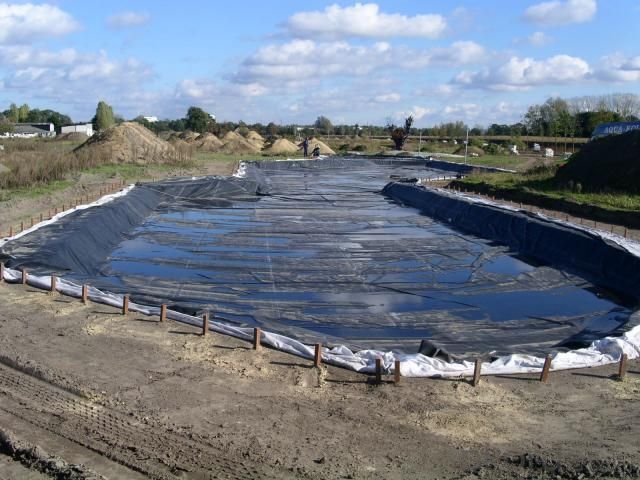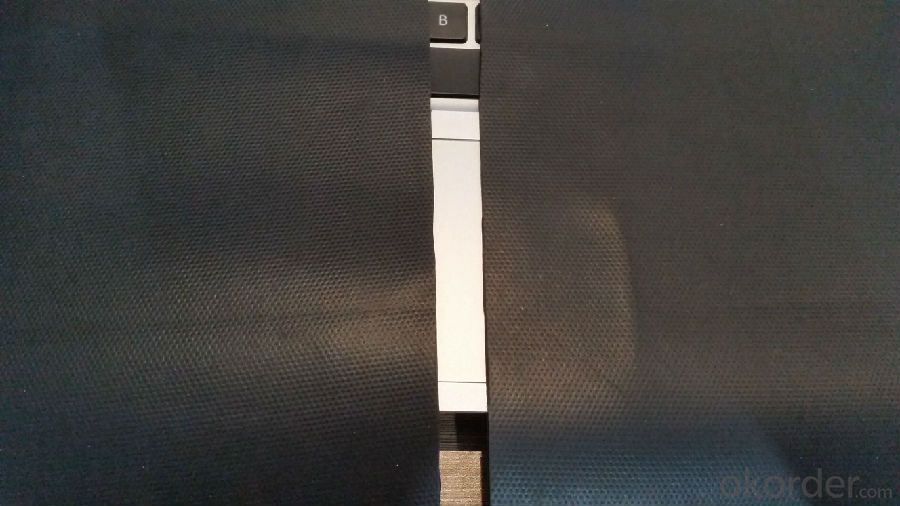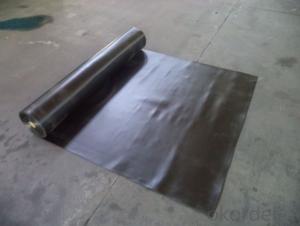EPDM Waterproof Vulcanized Membrane with 2.0mm Thickness
- Loading Port:
- Shanghai
- Payment Terms:
- TT or LC
- Min Order Qty:
- 20000 m²
- Supply Capability:
- 5000000 m²/month
OKorder Service Pledge
OKorder Financial Service
You Might Also Like
EPDM Waterproof Vulcanized Membrane with 2.0mm Thickness
Description Of EPDM Waterproof Vulcanized Membrane with 2.0mm Thickness:
1. EPDM waterproof membrane is made from ternary ethylene-propylene rubber, which is for waterproofing of exposed and non-exposed applications.
2. EPDM waterproof membrane production adopts the world-advanced equipment of cold feeding extrusion and continuous vulcanization technology.
3. EPDM waterproof membrane is of high elasticity among high polymer waterproof materials and becomes a world-popular waterproofing material.
Main Features of EPDM Waterproof Vulcanized Membrane with 2.0mm Thickness:
1.Excellent anti-aging performance, service life can reach 50 years;
2.High elongation, high tensile strength, heat treatment size change small;
3.Plant root penetration resistance is good
4.Good low temperature flexibility
5.Application is convenient, overlapping is firm and reliable, no environmental pollution;
6. Resistance to chemical corrosion, can be applied to special places;
7.Maintenance is convenient, the cost is low
Specifications of EPDM Waterproof Vulcanized Membrane with 2.0mm Thickness:
ITEM | STANDARO REQUEST | |
Tensile strength at breaking,normal temperature,Mpa | ≥7.5 | |
Elongation at breaking, % | ≥450 | |
Tearing strenght,KN/m | ≥25 | |
Bending at low temperature | ≤-40°C | |
Water impermeability,0.1Mpa×30min | Impermeability | |
Hot air aging 80°C×168h | Unchanging of tensile strength at breaking,% | ≥80 |
Unchanging of elongation at breaking,% | ≥70 | |
Appearance of 100% elongation | No crack | |
Property of anti alkali 10% Ca(OH)2×168h normal temperature | ≥80 | |
≥80 | ||
Applications of EPDM Waterproof Vulcanized Membrane with 2.0mm Thickness:
1.Roofs, Basement, Toilets
2. Industrial and civil building waterproofing
3. Geosynthetic liner for swimming pool, channels, irrigation system
4. Especially suitable for projects with high requirements in durability, anti-corrosion and deformation.



IMages of EPDM Waterproof Vulcanized Membrane with 2.0mm Thickness:




FAQ of EPDM EPDM Waterproof Vulcanized Membrane with 2.0mm Thickness:
1. What are we supplying?
We are specialized in producing Colorful Asphalt Roof Shingle, SBS/APP modified bitumen waterproof membrane, Self adhesive bitumen waterproof membrane, PVC waterproofing membrane, EPDM rubber roofing membrane, Single Component Polyurethane Waterproof Coating, and Spray Polyurea Waterproof Coating
.
2. How Many years experience do we have?
We have been exported to more than 20 countries in the past 15 years.
3. How long do we usually reply your request?
We always reply our customer within 24 hours.
- Q:Can a waterproofing membrane be used for industrial facilities and factories?
- Yes, a waterproofing membrane can be used for industrial facilities and factories. Industrial facilities and factories often have areas that are exposed to moisture, such as basements, rooftops, and storage areas. These areas are prone to water leakage and damage, which can result in costly repairs and downtime. A waterproofing membrane is a highly effective solution for protecting these areas from water infiltration. It is a flexible and durable barrier that is applied to surfaces to prevent water from penetrating through. Waterproofing membranes are designed to withstand various environmental conditions, including temperature changes, UV exposure, and chemical exposure, making them suitable for industrial settings. By installing a waterproofing membrane, industrial facilities and factories can prevent water damage, mold growth, and structural deterioration caused by moisture. This helps to maintain a safe and functional environment for workers and equipment, while also ensuring the longevity of the facility. Additionally, a waterproofing membrane can help to improve energy efficiency by reducing heat loss through insulation and preventing water-related damage to HVAC systems. Overall, using a waterproofing membrane in industrial facilities and factories is a practical and cost-effective solution for ensuring the protection and longevity of the facility.
- Q:Can a waterproofing membrane be used in historical or heritage buildings?
- Yes, a waterproofing membrane can be used in historical or heritage buildings. However, it should be done with caution and expertise to ensure that the membrane does not compromise the historical integrity or aesthetic value of the building. The selection and installation of the membrane should be carried out by professionals who understand the specific requirements and challenges associated with preserving the architectural significance of such buildings.
- Q:Can a waterproofing membrane be used for retaining walls?
- Yes, a waterproofing membrane can be used for retaining walls. Waterproofing membranes are commonly used to prevent water infiltration and protect structures from moisture damage. Applying a waterproofing membrane to a retaining wall can help prevent water seepage, reduce hydrostatic pressure, and extend the lifespan of the wall by preventing water-related deterioration.
- Q:Can a waterproofing membrane be used on foam block surfaces?
- Yes, a waterproofing membrane can be used on foam block surfaces. Foam blocks, such as expanded polystyrene (EPS) or extruded polystyrene (XPS), are often used as insulation in buildings. However, foam blocks are not inherently waterproof and can absorb moisture if left unprotected. To prevent water infiltration and potential damage, a waterproofing membrane can be applied to the foam block surfaces. The membrane acts as a barrier, preventing water from seeping into the foam and protecting it from moisture-related issues such as mold, mildew, or degradation. It is important to select a waterproofing membrane that is compatible with foam block surfaces and follow the manufacturer's instructions for proper application. Additionally, it is recommended to consult with a professional or a building engineer to ensure the appropriate waterproofing solution is chosen for the specific foam block application.
- Q:Are there any specific building code requirements for using a waterproofing membrane?
- Different jurisdictions have specific building code requirements when it comes to using a waterproofing membrane. These requirements often include certain standards that the membrane must meet, as well as instructions for its installation provided by the manufacturer. The building codes may specify the type of membrane to be used, its minimum thickness, and the method by which it should be installed. For instance, the International Building Code (IBC) mandates that waterproofing membranes must be listed and labeled by an approved testing agency. The code also demands that the membrane be installed in a way that offers continuous protection and can withstand expected structural movements and environmental conditions. Apart from the type and installation requirements, building codes may also outline the procedures for testing and inspecting waterproofing membranes. This is done to guarantee that the membrane is correctly installed and will effectively prevent moisture intrusion, thus safeguarding the building against potential damage and deterioration. To ensure compliance with these requirements and to have a waterproofing membrane that meets the necessary standards, it is crucial to consult the local building code or seek assistance from a qualified professional.
- Q:On the roof of the waterproofing membrane paving the direction of what are the requirements
- ?The purpose of the above provisions is to prevent the flow of membrane waterproof layer at the same time, as far as possible to reduce the coil waterproof layer of the joints to ensure that the integrity of the membrane waterproof layer, The probability of leakage of water.?When the roof slope is less than 15% (ie, gentle slope roof), parallel roof ridge direction of the film has the following advantages: (1) a web can be paved in the end, reducing the joints, saving raw materials; (2) (4) to maximize the use of the longitudinal tensile strength of linoleum, in the long-term lap joints are perpendicular to the direction of the flow of the roof slope, so that the most difficult to leak; (4) to maximize the use of the longitudinal tensile strength of linoleum, in the To a certain extent, improve the membrane roof cracking resistance.
- Q:Does a waterproofing membrane have any fire-resistant properties?
- Negative, a waterproofing membrane does not possess any innate fire-resistant qualities. The primary purpose of waterproofing membranes is to hinder the entry of water and moisture, but they are not specifically formulated to endure fire or impede the propagation of flames. It is noteworthy that although certain waterproofing membranes may exhibit certain fire-retardant characteristics, this is not a universal trait among all waterproofing materials. Consequently, it is imperative to separately consider fire safety precautions when designing or erecting a building or structure.
- Q:Are there different waterproofing membrane options for above-ground and below-ground applications?
- Yes, there are different waterproofing membrane options for above-ground and below-ground applications. Above-ground waterproofing membranes are typically designed to protect structures from moisture and weather elements, such as rain and UV rays. These membranes are often more focused on preventing water intrusion from the outside. On the other hand, below-ground waterproofing membranes are specifically designed to resist the hydrostatic pressure exerted by groundwater. They are more robust and are often used in basements, foundations, and other below-grade applications to prevent water penetration from the soil.
- Q:Can a waterproofing membrane be used in industrial facilities or warehouses?
- In industrial facilities or warehouses, it is possible to utilize a waterproofing membrane. These types of facilities typically have concrete floors or walls that are prone to water damage caused by leaks or moisture. By applying a waterproofing membrane, it becomes possible to shield these areas from water penetration, thereby preventing any potential harm to the structure and its contents. The purpose of waterproofing membranes is to establish a barrier that effectively prevents water from seeping through the surface, making them a practical solution for industrial facilities and warehouses where moisture control is of utmost importance. Furthermore, these membranes possess durability and can endure heavy foot traffic and equipment, making them ideal for use in areas with high levels of activity. Ultimately, the utilization of a waterproofing membrane in industrial facilities or warehouses plays a crucial role in maintaining a dry and secure environment, ensuring the protection of the structure and its contents.
- Q:Can a waterproofing membrane be used for a swimming pool liner installation?
- Certainly! When it comes to installing a swimming pool liner, utilizing a waterproofing membrane is indeed a viable option. These membranes are meticulously crafted to establish a formidable shield against water infiltration, rendering them a superb selection for pool lining purposes. Typically composed of resilient substances like PVC or EPDM, these membranes possess remarkable resistance to both chemicals and UV rays. Consequently, they proficiently halt the permeation of water through the pool structure, shielding it from the detrimental effects induced by moisture. Moreover, the flexibility inherent in waterproofing membranes enables effortless tailoring to accommodate pools of diverse shapes and dimensions, ensuring a flawless and impervious installation.
1. Manufacturer Overview |
|
|---|---|
| Location | |
| Year Established | |
| Annual Output Value | |
| Main Markets | |
| Company Certifications | |
2. Manufacturer Certificates |
|
|---|---|
| a) Certification Name | |
| Range | |
| Reference | |
| Validity Period | |
3. Manufacturer Capability |
|
|---|---|
| a)Trade Capacity | |
| Nearest Port | |
| Export Percentage | |
| No.of Employees in Trade Department | |
| Language Spoken: | |
| b)Factory Information | |
| Factory Size: | |
| No. of Production Lines | |
| Contract Manufacturing | |
| Product Price Range | |
Send your message to us
EPDM Waterproof Vulcanized Membrane with 2.0mm Thickness
- Loading Port:
- Shanghai
- Payment Terms:
- TT or LC
- Min Order Qty:
- 20000 m²
- Supply Capability:
- 5000000 m²/month
OKorder Service Pledge
OKorder Financial Service
Similar products
New products
Hot products
Related keywords






























